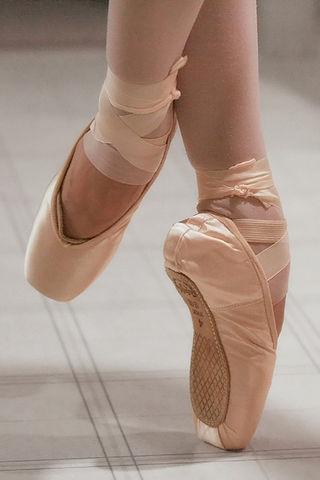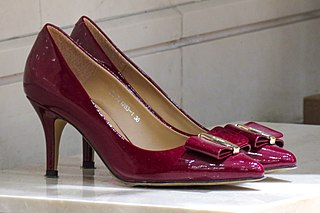
The foot is an anatomical structure found in many vertebrates. It is the terminal portion of a limb which bears weight and allows locomotion. In many animals with feet, the foot is a separate organ at the terminal part of the leg made up of one or more segments or bones, generally including claws and/or nails.

A shoe is an item of footwear intended to protect and comfort the human foot. Though the human foot can adapt to varied terrains and climate conditions, it is vulnerable, and shoes provide protection. Form was originally tied to function, but over time, shoes also became fashion items. Some shoes are worn as safety equipment, such as steel-toe boots, which are required footwear at industrial worksites.

Footwear refers to garments worn on the feet, which typically serve the purpose of protection against adversities of the environment such as wear from rough ground; stability on slippery ground; and temperature.

Fetish fashion is any style or appearance in the form of a type of clothing or accessory, created to be extreme, revealing, skimpy, or provocative in a fetishistic manner. These styles are by definition not worn by the majority of people; if everyone wears an item, it cannot have fetishistic, special nature. They are usually made of materials such as leather, latex or synthetic rubber or plastic, nylon, PVC, spandex, fishnet, and stainless steel. Some fetish fashion items include: stiletto heel shoes and boots, hobble skirts, corsets, collars, full-body latex catsuits, stockings, miniskirt, crotchless underwear, jockstraps, diapers, garters, locks, rings, zippers, eyewear, handcuffs, and stylized costumes based on more traditional outfits, such as wedding dresses that are almost completely see-through lace, or lingerie for men.

A boot is a type of footwear. Most boots mainly cover the foot and the ankle, while some also cover some part of the lower calf. Some boots extend up the leg, sometimes as far as the knee or even the hip. Most boots have a heel that is clearly distinguishable from the rest of the sole, even if the two are made of one piece. Traditionally made of leather or rubber, modern boots are made from a variety of materials.

The Wellington boot, often shortened to welly and also known as the gumboot, is a type of waterproof boot.

A pointe shoe, also called a ballet shoe, is a type of shoe worn by ballet dancers when performing pointe work. Pointe shoes were conceived in response to the desire for dancers to appear weightless and sylph-like and have evolved to enable dancers to dance en pointe for extended periods of time. They are manufactured in a variety of colors, most commonly in shades of light pink.

Thigh-high boots, known also as thigh-length boots or simply thigh boots, are boots that extend above the knees to at least mid-thigh. Other terms for this footwear include over-the-knee boots, a name originally used for 15th century riding boots for men. These are sometimes called pirate boots, especially when cuffed. Over-the-knee boots are sometimes abbreviated to OTK boots. Lengths vary from reaching just over the knee to reaching almost to the crotch.

Pointe technique is part of classical ballet involving a technique that concerns pointe work, in which a ballet dancer supports all body weight on the tips of fully extended feet when wearing pointe shoes. A dancer is said to be en pointe when the body is supported in this manner, and a fully extended vertical foot is said to be en pointe when touching the floor, even when not bearing weight.

Sandals are an open type of shoe, consisting of a sole held to the wearer's foot by straps going over the instep and around the ankle. Sandals can also have a heel. While the distinction between sandals and other types of footwear can sometimes be blurry, the common understanding is that a sandal leaves all or most of the foot exposed. People may choose to wear sandals for several reasons, among them comfort in warm weather, economy, and as a fashion choice. Usually, people wear sandals in warmer climates or during warmer parts of the year in order to keep their feet cool and dry. The risk of developing athlete's foot is lower than with enclosed shoes, and the wearing of sandals may be part of the treatment regimen for such an infection.

Jump boots are a type of combat boot designed for paratroopers featuring calf-length lacing and rigid toe caps. The style was developed in many countries simultaneously with the adoption of airborne infantry forces during World War II. Modern jump boots are earned in some countries and therefore have become a mark of achievement and distinction, mainly worn as dress and parade boots. The uppers are generally made of smooth black leather with toe-caps and heel counters that accept a high polish. It is also a paratrooper tradition to lace jump boots in a ladder or cobweb style which increases ankle support during a parachute jump.

Boot fetishism is a sexual fetish focused on boots. Boots have become the object of sexual attraction amounting to fetishism for some people and they have become a standard accessory in BDSM scenes and a fashion accessory in music videos. Boots are seen as perhaps the most fetishistic of all footwear and boots are the most popular fetish clothing attire.

High-heeled shoes, also known as high heels or pumps, are a type of shoe with an upward-angled sole. The heel in such shoes is raised above the ball of the foot. High heels cause the legs to appear longer, make the wearer appear taller, and accentuate the calf muscle.

A court shoe or pump is a shoe with a low-cut front, or vamp, with either a shoe buckle or a black bow as ostensible fastening. Deriving from the 17th- and 18th-century dress shoes with shoe buckles, the vamped pump shape emerged in the late 18th century. By the turn of the 19th century, shoe buckles were increasingly replaced by black bows, which has remained the contemporary style for men's formal wear, leather or patent leather evening pumps ever since. This latter style is sometimes also called an opera pump or opera slipper.

A ballet shoe, or ballet slipper, is a lightweight shoe designed specifically for ballet dancing. It may be made from soft leather, canvas, or satin, and has flexible, thin full or split soles. Traditionally, women wear pink shoes and men wear white or black shoes. Skin-colored slippers—which are unobtrusive and thus give the appearance of dancing barefoot—are worn in modern ballets and sometimes modern dancing by both men and women.

Tiptoe describes the human body posture and locomotion of removing the heel(s) of one or both feet from the ground. The term is mostly used colloquially when the weight is placed on the balls of the feet rather than literally on the tips of the toes; literal tip-toeing is difficult but possible, as in the pointe technique of ballet. In running, landing on the ball of the foot is known as forefoot strike.

Ballet flats of ballet pumps are women's shoes for everyday wear which are similar to/inspired by a women's ballet shoes, with a very thin heel or the appearance of no heel at all. The style sometimes features a ribbon-like binding around the low tops of the slipper and may have a slight gathering at the top-front of the vamp and sometimes a tiny, decorative string tie. Ballet slippers can be adjusted and tightened to the wearer's foot by means of this string tie.

A fashion boot is a boot worn for reasons of style or fashion. The term is usually applied to women's boots. Fashion boots come in a wide variety of styles, from ankle to thigh-length, and are used for casual, formal, and business attire. Although boots were a popular style of women's footwear in the 19th century, they were not recognized as a high fashion item until the 1960s. They became widely popular in the 1970s and have remained a staple of women's winter wardrobes since then.

The toe box is the section of footwear that surrounds the toes on closed-toe shoes. Toe boxes that are too tight can cause injuries and foot deformities, whereas wider toe boxes may be used to treat or prevent common foot conditions such as Morton's neuroma. Toe boxes come in a variety of shapes and styles of construction, some of which are a matter of fashion, and some of which are designed for specialized functions.


















